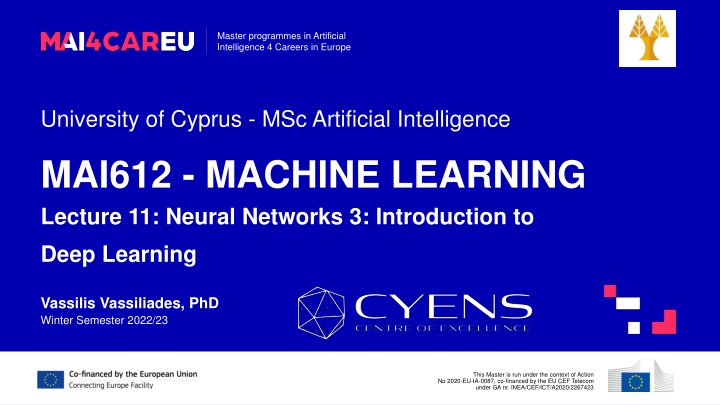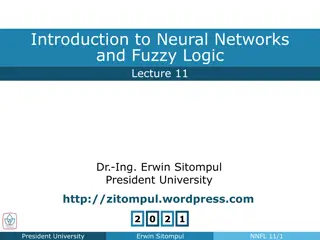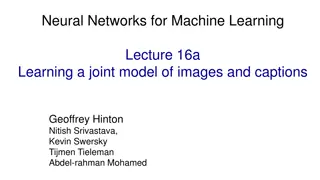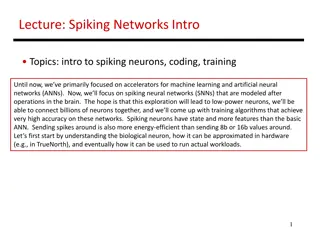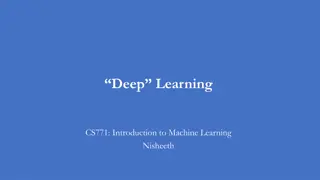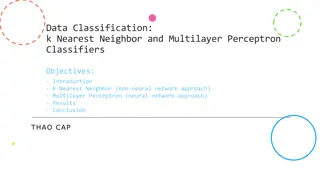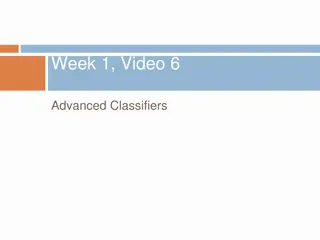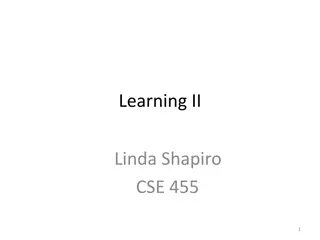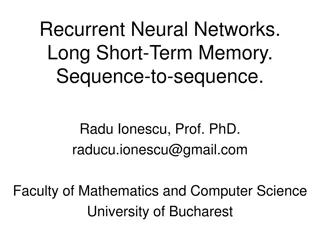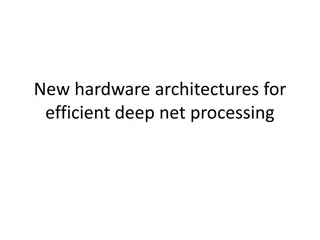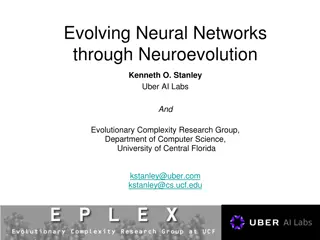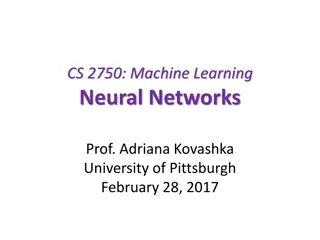Introduction to Deep Learning: Neural Networks and Multilayer Perceptrons
Explore the fundamentals of neural networks, including artificial neurons and activation functions, in the context of deep learning. Learn about multilayer perceptrons and their role in forming decision regions for classification tasks. Understand forward propagation and backpropagation as essential processes in training neural networks for regression or classification. This master program at the University of Cyprus delves into the practical applications of artificial intelligence in Europe, supported by EU funding.
Download Presentation

Please find below an Image/Link to download the presentation.
The content on the website is provided AS IS for your information and personal use only. It may not be sold, licensed, or shared on other websites without obtaining consent from the author.If you encounter any issues during the download, it is possible that the publisher has removed the file from their server.
You are allowed to download the files provided on this website for personal or commercial use, subject to the condition that they are used lawfully. All files are the property of their respective owners.
The content on the website is provided AS IS for your information and personal use only. It may not be sold, licensed, or shared on other websites without obtaining consent from the author.
E N D
Presentation Transcript
Master programmes in Artificial Intelligence 4 Careers in Europe University of Cyprus - MSc Artificial Intelligence MAI612 - MACHINE LEARNING Lecture 11: Neural Networks 3: Introduction to Deep Learning Vassilis Vassiliades, PhD Winter Semester 2022/23 This Master is run under the context of Action No 2020-EU-IA-0087, co-financed by the EU CEF Telecom under GA nr. INEA/CEF/ICT/A2020/2267423
Master programmes in Artificial Intelligence 4 Careers in Europe Revision This Master is run under the context of Action No 2020-EU-IA-0087, co-financed by the EU CEF Telecom under GA nr. INEA/CEF/ICT/A2020/2267423
Master programmes in Artificial Intelligence 4 Careers in Europe Neural Networks Artificial Neural Networks (ANNs) are models inspired by the human brain Composed of many simple processing elements called artificial neurons Artificial neurons compute the weighted sum of their inputs and feed it through an activation function which then becomes their output Activation functions: Heaviside step (non-differentiable) Perceptron model Linear Linear regression Sigmoid Logistic regression Perceptrons are linear classifiers By combining multiple perceptrons in layers we can classify nonlinearly separable problems E.g., XOR can be solved using 2 hidden neurons and 1 output neuron However, we cannot train them using gradient descent when they use the Heaviside step function as it is non-differentiable This Master is run under the context of Action No 2020-EU-IA-0087, co-financed by the EU CEF Telecom under GA nr. INEA/CEF/ICT/A2020/2267423 3
Master programmes in Artificial Intelligence 4 Careers in Europe Neural Networks Multilayer Perceptrons is a synonym for feedforward ANNs (typically with differentiable activation functions) As a classifier, an MLP with: 1 hidden layer forms open or convex decision regions 2 hidden layers create arbitrary decision regions Forward propagation is the process that feeds a data instance to the input layer of a NN and this is gradually transformed into the output prediction (regression or classification) through some nonlinear transformation. This nonlinear transformation computes features of the input which are learned A second hidden layer computes features as functions of existing features Learning in NNs can be done using backpropagation and gradient descent This Master is run under the context of Action No 2020-EU-IA-0087, co-financed by the EU CEF Telecom under GA nr. INEA/CEF/ICT/A2020/2267423 4
Master programmes in Artificial Intelligence 4 Careers in Europe Neural Networks Backpropagation: an efficient way to compute partial derivatives of the error function with respect to each parameter using the chain rule (since a NN is a composition of functions) Error function: MSE for regression, Cross-Entropy for classification Forward propagation computes the activation (output) of each node, while Backpropagation computes the error (delta) of each node Delta (error) of each node: A x B A = derivative of the node s activation function B = derivative of error with respect to the node s output For an output node: this is the derivative of the error function wrt to the activation of the output node For a hidden node i at layer k: this is the sum of all deltas at nodes in layer k+1 (which are connected to node i) multiplied by their connecting weight Gradient of the Error wrt to a weight = (delta of postsynaptic node) x (output of presynaptic node) This Master is run under the context of Action No 2020-EU-IA-0087, co-financed by the EU CEF Telecom under GA nr. INEA/CEF/ICT/A2020/2267423 5
Master programmes in Artificial Intelligence 4 Careers in Europe Neural Networks Stochastic GD: weight update after the presentation of every pattern Batch GD: weight update after the presentation of all patterns in the training set Mini-batch GD: weight update after the presentation of subsets of patterns in the training set Momentum term: memory of previous direction, speeds up learning Early stopping: way to prevent overfitting by stopping training when the validation error starts increasing We can improve the performance of NN models using regularization, hyperparameter tuning and ensembles Learning the NN topology can be done using gradient-free methods, such as evolutionary algorithms. This Master is run under the context of Action No 2020-EU-IA-0087, co-financed by the EU CEF Telecom under GA nr. INEA/CEF/ICT/A2020/2267423 6
Master programmes in Artificial Intelligence 4 Careers in Europe Lecture 11: Neural Networks 3: Introduction to Deep Learning Learning Outcomes You will learn about: 6. The vanishing and exploding gradient problem 1. What deep learning is and why use it 7. Echo State Networks 2. Convolutional networks for image data 8. Long short-term memory (LSTM) networks 3. Handling sequential data 9. Word embeddings for handling text 4. Recurrent neural networks 5. Backpropagation through time This Master is run under the context of Action No 2020-EU-IA-0087, co-financed by the EU CEF Telecom under GA nr. INEA/CEF/ICT/A2020/2267423 7
Master programmes in Artificial Intelligence 4 Careers in Europe From Machine Learning to Deep Learning ML model transforms input data into meaningful outputs Learned using examples How to meaningfully transform data? How to learn representations of the input data that get us closer to the expected output Representation: different way to look at the data to represent or encode the data Examples: Color image can be encoded in the RGB (red-green-blue) or HSV (hue-saturation-value) format Points on a plane can be represented using Cartesian (x,y) or polar (r, ) coordinates Some tasks may be difficult with one representation and easier with another. Example: Task: select all red pixels in the image simpler with RGB format Task: make the image less saturated simpler in the HSV format ML models are all about finding appropriate representations for their input data transformations of the data that make it more manageable for the task at hand (e.g., classification) Adapted from: Chollet, F. (2018). Deep Learning with Python. Manning Publications. This Master is run under the context of Action No 2020-EU-IA-0087, co-financed by the EU CEF Telecom under GA nr. INEA/CEF/ICT/A2020/2267423 8
Master programmes in Artificial Intelligence 4 Careers in Europe What is Deep Learning Deep Learning is a subfield of ML that focuses on learning successive layers of meaningful representations using neural networks. Deep = Successive layers of representation Other potential names: layered representations learning, hierarchical representations learning How many layers are considered deep ? 2 layers of representations: shallow learning >2 layers: deep learning Often: tens or hundreds of successive representations source Adapted from: Chollet, F. (2018). Deep Learning with Python. Manning Publications. This Master is run under the context of Action No 2020-EU-IA-0087, co-financed by the EU CEF Telecom under GA nr. INEA/CEF/ICT/A2020/2267423 9
Master programmes in Artificial Intelligence 4 Careers in Europe Why deep learning? Why now? 1. Hardware 1990-2010: CPUs became faster by a factor of ~5000 Throughout the 2000s companies like NVIDIA and AMD have been heavily investing in developing fast, massively parallel chips (graphics processing units [GPUs]) to power the graphics of increasingly photorealistic video games 2007: NVIDIA launched the CUDA programming interface for its line of GPUs Small number of GPUs replace massive clusters of CPUs in various highly parallelizable applications (e.g., physics modeling) 2011-2012: First CUDA implementations of NNs that won competitions (e.g., ImageNet) The deep-learning industry is starting to go beyond GPUs (e.g., Tensor Processing Units [TPUs]) Adapted from: Chollet, F. (2018). Deep Learning with Python. Manning Publications. This Master is run under the context of Action No 2020-EU-IA-0087, co-financed by the EU CEF Telecom under GA nr. INEA/CEF/ICT/A2020/2267423 10
Master programmes in Artificial Intelligence 4 Careers in Europe Why deep learning? Why now? 2. Datasets and benchmarks AI is the new industrial revolution If AI is the steam engine of this revolution, then data is its coal Exponential progress in storage hardware over the past 20 years Game changer: rise of the Internet, makes it feasible to collect and distribute very large datasets for ML Today: companies work with image datasets, video datasets and natural-language datasets that could not have been collected without the internet ImageNet dataset: Catalyst for the rise of deep learning 1.4 million images hand annotated with 1000 image categories Yearly competition Public competitions (e.g., Kaggle): excellent way to motivate researchers to advance the state of the art Adapted from: Chollet, F. (2018). Deep Learning with Python. Manning Publications. This Master is run under the context of Action No 2020-EU-IA-0087, co-financed by the EU CEF Telecom under GA nr. INEA/CEF/ICT/A2020/2267423 11
Master programmes in Artificial Intelligence 4 Careers in Europe Why deep learning? Why now? 3. Algorithmic advances Until the 2000s, we were missing reliable ways to train deep NNs NNs were shallow (1-2 hidden layers), unable to compete against SVMs or Random Forests Key issue: gradient faded away as number of layers increased 2009-2016: Algorithmic improvements allow better gradient propagation: Better activation functions for neural layers Better weight initialization schemes, starting with layer-wise pretraining, which was abandoned Better optimization schemes (e.g., RMSProp, Adam) Batch normalization Residual connections However, older techniques such as LSTMs were now feasible because of hardware & data Adapted from: Chollet, F. (2018). Deep Learning with Python. Manning Publications. This Master is run under the context of Action No 2020-EU-IA-0087, co-financed by the EU CEF Telecom under GA nr. INEA/CEF/ICT/A2020/2267423 12
Master programmes in Artificial Intelligence 4 Careers in Europe Why deep learning? Why now? 4. A new wave of investment Deep learning (DL) became the new state of the art for computer vision in 2012-2013 and eventually all perceptual tasks industry leaders took notice Gradual wave of industry investment afterwards, far beyond anything previously seen in the history of AI. For example, the total venture capital investment in AI: 2011 (before deep learning spotlight) = ~$19M 2014: ~$394M 2013: Google acquired DeepMind for $500M (largest acquisition of an AI startup) 2014: Baidu started a DL research centre in Silicon Valley (investing $300M) Deep Learning became central to the product strategy of tech giants Research and number of people working on/with deep learning increased exponentially over the last years Adapted from: Chollet, F. (2018). Deep Learning with Python. Manning Publications. This Master is run under the context of Action No 2020-EU-IA-0087, co-financed by the EU CEF Telecom under GA nr. INEA/CEF/ICT/A2020/2267423 13
Master programmes in Artificial Intelligence 4 Careers in Europe Why deep learning? Why now? 5. The democratization of deep learning Early days required significant C++ and CUDA expertise, which few people possessed Nowadays, basic Python scripting skills suffice to do advanced DL research This has been driven primarily by the development of Theano, TensorFlow, and PyTorch: symbolic tensor1-manipulation frameworks for Python that support autodifferentiation Rise of user-friendly libraries, such as Keras, which makes DL easy Culture on uploading papers on arXiv and releasing the code as open-source (see paperswithcode) 1Tensor: Generalizaton of a matrix to N-dimensional space Adapted from: Chollet, F. (2018). Deep Learning with Python. Manning Publications. This Master is run under the context of Action No 2020-EU-IA-0087, co-financed by the EU CEF Telecom under GA nr. INEA/CEF/ICT/A2020/2267423 14
Master programmes in Artificial Intelligence 4 Careers in Europe Structure helps learning What do you think would be easier for a classifier to learn? If data has some structure and the NN does not need to learn the structure from scratch, then the NN will perform better 1. A model that uses the color image? Example: Letter classification R G B CLASSIFIER Color does not matter! b 2. A model that only looks at the gray scale? A Dc R+G+B 3 CLASSIFIER Adapted from Udacity s Deep Learning course This Master is run under the context of Action No 2020-EU-IA-0087, co-financed by the EU CEF Telecom under GA nr. INEA/CEF/ICT/A2020/2267423 15
Master programmes in Artificial Intelligence 4 Careers in Europe Statistical Invariance Example: Dog image classification Does not matter where the dog is, it is still an image with a dog We should explicitly teach a NN that objects in images are the same irrespective of where they are in the image This is called Translation Invariance Adapted from Udacity s Deep Learning course This Master is run under the context of Action No 2020-EU-IA-0087, co-financed by the EU CEF Telecom under GA nr. INEA/CEF/ICT/A2020/2267423 16
Master programmes in Artificial Intelligence 4 Careers in Europe Statistical Invariance Example: Text that talks about dogs The quick brown dog jumped over the lazy white dog. Once upon a time, there was a dog with pointy ears and a short tail. Does the meaning of dog change depending on whether it is in the 1stsentence or the 2ndone? No We want the part of the NN that learns what a dog is to be reused every time the NN sees the word dog, and not to re-learn it every time. Adapted from Udacity s Deep Learning course This Master is run under the context of Action No 2020-EU-IA-0087, co-financed by the EU CEF Telecom under GA nr. INEA/CEF/ICT/A2020/2267423 17
Master programmes in Artificial Intelligence 4 Careers in Europe Statistical Invariance: Weight sharing When we know that 2 or more inputs contain the same information then we share their weights and train the weights jointly for those inputs Statistical invariants: things that do not change on average across time or space The quick brown dog jumped over the lazy white dog. ?? ?? ?? ?? Convolutional Networks Embeddings or Recurrent NNs ?? Once upon a time, there was a dog with pointy ears and a short tail. Text or Sequences Image Data Adapted from Udacity s Deep Learning course This Master is run under the context of Action No 2020-EU-IA-0087, co-financed by the EU CEF Telecom under GA nr. INEA/CEF/ICT/A2020/2267423 18
Master programmes in Artificial Intelligence 4 Careers in Europe Image Data This Master is run under the context of Action No 2020-EU-IA-0087, co-financed by the EU CEF Telecom under GA nr. INEA/CEF/ICT/A2020/2267423
Master programmes in Artificial Intelligence 4 Careers in Europe Image Data Example: Classification task Input: 256x256x3 (RGB) tensor Output: Cat or not cat Suppose that we use an MLP with 1 fully connected (FC) hidden layer of 100 neurons 196,608 x 100 (input to hidden) + 100 (hidden to output) = 19,660,900 parameters! Cons: MLPs require a huge amount of parameters (prone to overfitting) MLPs do not account for translational invariance This Master is run under the context of Action No 2020-EU-IA-0087, co-financed by the EU CEF Telecom under GA nr. INEA/CEF/ICT/A2020/2267423 20
Master programmes in Artificial Intelligence 4 Careers in Europe Convolutional Networks (ConvNets) Convolutional NNs are regularized versions of MLPs, i.e., they reduce the number of parameters and try to account for translation invariance, based on 3 ideas: Local receptive fields Each neuron receives input only from a restricted area of the previous layer (typically a square, e.g., 5x5) The learnable parameters of each such neuron are called a filter or a kernel In contrast, the receptive field of FC layers is the entire previous layer Weight sharing Each filter is convolved with the previous layer, i.e., slices over the previous entire activation map (e.g., the original image) and computes the dot product between the filter entries and the input patch The output of this operation is an activation map for each filter Spatial sub-sampling (pooling) [optional] Reduces the dimensions of the data by combining the outputs of neuron clusters into a single number Typically, max-pooling or average pooling This Master is run under the context of Action No 2020-EU-IA-0087, co-financed by the EU CEF Telecom under GA nr. INEA/CEF/ICT/A2020/2267423 21
Master programmes in Artificial Intelligence 4 Careers in Europe Convolutional Networks (ConvNets) Convolution Local receptive field: 3x3 filter Weight sharing: only 9 parameters are learned to produce the output activation map (of this filter) This Master is run under the context of Action No 2020-EU-IA-0087, co-financed by the EU CEF Telecom under GA nr. INEA/CEF/ICT/A2020/2267423 22
Master programmes in Artificial Intelligence 4 Careers in Europe Convolutional Networks (ConvNets) Pooling source This Master is run under the context of Action No 2020-EU-IA-0087, co-financed by the EU CEF Telecom under GA nr. INEA/CEF/ICT/A2020/2267423 23
Master programmes in Artificial Intelligence 4 Careers in Europe Convolutional Networks This Master is run under the context of Action No 2020-EU-IA-0087, co-financed by the EU CEF Telecom under GA nr. INEA/CEF/ICT/A2020/2267423 24
Master programmes in Artificial Intelligence 4 Careers in Europe What ConvNets learn Each layer in the hierarchy learns progressively better representations Input layer: original pixel values Layer 1: presence/absence of edges of particular orientation at particular position Layer 2: local arrangements of edges Layer 3: assemblies of local arrangements that may correspond to parts of objects Layer 4: combinations of parts of objects that may represent complete objects Output Layer: classification This Master is run under the context of Action No 2020-EU-IA-0087, co-financed by the EU CEF Telecom under GA nr. INEA/CEF/ICT/A2020/2267423 25
Master programmes in Artificial Intelligence 4 Careers in Europe Applications of ConvNets Every task that requires image data: Image recognition Video recognition Image classification Image segmentation Medical image analysis Can also be used for other types of data: Natural language processing Time series forecasting This Master is run under the context of Action No 2020-EU-IA-0087, co-financed by the EU CEF Telecom under GA nr. INEA/CEF/ICT/A2020/2267423 26
Master programmes in Artificial Intelligence 4 Careers in Europe Sequential Data This Master is run under the context of Action No 2020-EU-IA-0087, co-financed by the EU CEF Telecom under GA nr. INEA/CEF/ICT/A2020/2267423
Master programmes in Artificial Intelligence 4 Careers in Europe Sequential data Sequential data refers to any data that contain elements that are ordered into sequences The order differentiates this data from other cases we have seen so far Examples: The price of a stock over time Environmental data (pressure, temperature, precipitation etc.) over time Sequence of queries in a search engine, or the frequency of a query over time EEG signals A DNA sequence of nucleotides The words in a document as they appear in order Event occurrences in a log Video-based action recognition This Master is run under the context of Action No 2020-EU-IA-0087, co-financed by the EU CEF Telecom under GA nr. INEA/CEF/ICT/A2020/2267423 28
Master programmes in Artificial Intelligence 4 Careers in Europe Time-series data Time series: Typical case of sequential data Vector of numeric values that change over time Typically, collected at regular intervals Components: Trends: smooth long-term direction Seasonality: patterns of change within a year which tend to repeat each year Cyclic variation: rise and fall over periods typically longer than a year Noise: random variation / unpredictable component This Master is run under the context of Action No 2020-EU-IA-0087, co-financed by the EU CEF Telecom under GA nr. INEA/CEF/ICT/A2020/2267423 29
Master programmes in Artificial Intelligence 4 Careers in Europe Quiz Sequential data and time-series data mean exactly the same thing. True or False? False. There exist data that contains elements whose order is not defined by a time axis. For example, a DNA sequence, or words in a document. Nevertheless, in most applications, sequential data are temporal data. In the following slides, we will be using the word order and time synonymously. This Master is run under the context of Action No 2020-EU-IA-0087, co-financed by the EU CEF Telecom under GA nr. INEA/CEF/ICT/A2020/2267423 30
Master programmes in Artificial Intelligence 4 Careers in Europe Handling sequential data Why deal with sequential data? - Stock prices do not make sense without the time information - Individual words in a sentence do not make sense without their context How to handle sequential data? - Need some form of memory. - Two approaches: - Order is externally processed - Order is internally processed This Master is run under the context of Action No 2020-EU-IA-0087, co-financed by the EU CEF Telecom under GA nr. INEA/CEF/ICT/A2020/2267423 31
Master programmes in Artificial Intelligence 4 Careers in Europe External processing of order Order (or time) is preprocessed in an order-to-space transformation. Only the spatial transformation is accessed by the network, which contains a dimension whose semantics are related to the order. Feature engineering approach: introduction of new features (inputs) Shifted versions of the input signal, e.g., ??,?? 1,?? 2, ,?? ? Moving averages, e.g., ???,?= Need to define the length of the context (time) window, ? Sliding window on sequential data converts the sequence within the window into static data ? ?=? ? ?? ? This Master is run under the context of Action No 2020-EU-IA-0087, co-financed by the EU CEF Telecom under GA nr. INEA/CEF/ICT/A2020/2267423 32
Master programmes in Artificial Intelligence 4 Careers in Europe External processing of order: MLP Inflexible approach: Rigid limit on duration of patterns Does not capture the translational invariance of the same temporal pattern at different absolute times [0,0,1,1,1,0,0,1,0,0] [0,0,0,0,1,1,1,0,0,1] t t+2 Input layer of source nodes Layer of hidden neurons Layer of output neurons This Master is run under the context of Action No 2020-EU-IA-0087, co-financed by the EU CEF Telecom under GA nr. INEA/CEF/ICT/A2020/2267423 33
Master programmes in Artificial Intelligence 4 Careers in Europe Internal processing of order The model uses an internal state which is constantly updated according to an input stream, and maintains the preceding state of the nodes which is reintroduced at the following step. Typically done: At the neuron level: the neuron model introduces some delay when integrating the input and calculating the response At the connection level: the signal propagates from one neuron to the other with some delay This Master is run under the context of Action No 2020-EU-IA-0087, co-financed by the EU CEF Telecom under GA nr. INEA/CEF/ICT/A2020/2267423 34
Master programmes in Artificial Intelligence 4 Careers in Europe Internal processing of order: neuron level Example: discrete-time dynamic neuron model ?0= 1 ?0 ? ? ? + 1 = t + ???? ? ?1 ?1(?) ?=1 ?2 ?2(?) ?(?) (.) ? ? = ? ? ?0 ?(?) ?(? + 1) ?? ??(?) This Master is run under the context of Action No 2020-EU-IA-0087, co-financed by the EU CEF Telecom under GA nr. INEA/CEF/ICT/A2020/2267423 35
Master programmes in Artificial Intelligence 4 Careers in Europe Internal processing of order: connection level In feedforward networks, we consider that forward propagation, i.e., the propagation of an input signal all the way to the output layer is done in a single time step. ??,? ?? ?? ?? = ??,??? ??(?) = ??,???(?) ??,? ??(?) ??(?) ?= 0 ??(?) = ??,???(? 1) ??(?) = ??,???(? ?) ??,? Connections with a delay are known as recurrent connections. ??(?) ??(?) ?= 1 Neural networks that use recurrent connections are known as recurrent neural networks. This Master is run under the context of Action No 2020-EU-IA-0087, co-financed by the EU CEF Telecom under GA nr. INEA/CEF/ICT/A2020/2267423 36
Master programmes in Artificial Intelligence 4 Careers in Europe Recurrent Neural Networks This Master is run under the context of Action No 2020-EU-IA-0087, co-financed by the EU CEF Telecom under GA nr. INEA/CEF/ICT/A2020/2267423
Master programmes in Artificial Intelligence 4 Careers in Europe Recurrent Neural Networks: forward propagation Recurrent connections typically have a delay of 1 ?2,2 ?2(?) ?1 ? = ??,1? ? + ?1,1?1 ? 1 + ?2,1?2 ? 1 ?2,1 ?1,2 ?1,1 ?2 ? = ?1,2?1 ? + ?2,2?2 ? 1 ?1(?) ??,1 Every neuron that has an outgoing recurrent connection is said to maintain some state This is its activation which is needed at the next time step ?(?) This Master is run under the context of Action No 2020-EU-IA-0087, co-financed by the EU CEF Telecom under GA nr. INEA/CEF/ICT/A2020/2267423 38
Master programmes in Artificial Intelligence 4 Careers in Europe Training: Backpropagation through time Backpropagation can still be used to train recurrent neural networks Modification: forward propagation: unroll the computational graph over time, i.e., maintain all neuron states in memory for the length of the sequence, t = 1 to T backpropagate errors starting from the last time step (T) towards the first time step, while at each time step we also backpropagate errors from the output layer (if any) accumulate all gradients and apply gradient descent This Master is run under the context of Action No 2020-EU-IA-0087, co-financed by the EU CEF Telecom under GA nr. INEA/CEF/ICT/A2020/2267423 39
Master programmes in Artificial Intelligence 4 Careers in Europe Unroll the computational graph The network becomes very deep Source This Master is run under the context of Action No 2020-EU-IA-0087, co-financed by the EU CEF Telecom under GA nr. INEA/CEF/ICT/A2020/2267423 40
Master programmes in Artificial Intelligence 4 Careers in Europe Backpropagate errors Source This Master is run under the context of Action No 2020-EU-IA-0087, co-financed by the EU CEF Telecom under GA nr. INEA/CEF/ICT/A2020/2267423 41
Master programmes in Artificial Intelligence 4 Careers in Europe Apply parameter update Once all gradients are accumulated, we do a gradient descent step and modify the parameters Notice that we use weight sharing: the unrolled graph uses the same weights for the processing of different inputs in the sequence If the weights were different then it would be a type of feedforward neural network This enables RNNs to limit computational resources and process sequences of variable length Source This Master is run under the context of Action No 2020-EU-IA-0087, co-financed by the EU CEF Telecom under GA nr. INEA/CEF/ICT/A2020/2267423 42
Master programmes in Artificial Intelligence 4 Careers in Europe RNN Examples source Each rectangle is a vector and arrows represent functions (e.g. matrix multiply). Input vectors are in red, output vectors are in blue and green vectors hold the RNN's state This Master is run under the context of Action No 2020-EU-IA-0087, co-financed by the EU CEF Telecom under GA nr. INEA/CEF/ICT/A2020/2267423 43
Master programmes in Artificial Intelligence 4 Careers in Europe RNN Examples source Vanilla mode of processing without RNN, from fixed-sized input to fixed-sized output (e.g. image classification). This Master is run under the context of Action No 2020-EU-IA-0087, co-financed by the EU CEF Telecom under GA nr. INEA/CEF/ICT/A2020/2267423 44
Master programmes in Artificial Intelligence 4 Careers in Europe RNN Examples source Sequence output (e.g. image captioning takes an image and outputs a sentence of words). This Master is run under the context of Action No 2020-EU-IA-0087, co-financed by the EU CEF Telecom under GA nr. INEA/CEF/ICT/A2020/2267423 45
Master programmes in Artificial Intelligence 4 Careers in Europe RNN Examples source Sequence input (e.g. sentiment analysis where a given sentence is classified as expressing positive or negative sentiment). This Master is run under the context of Action No 2020-EU-IA-0087, co-financed by the EU CEF Telecom under GA nr. INEA/CEF/ICT/A2020/2267423 46
Master programmes in Artificial Intelligence 4 Careers in Europe RNN Examples source Sequence input and sequence output (e.g. Machine Translation: an RNN reads a sentence in English and then outputs a sentence in French). This Master is run under the context of Action No 2020-EU-IA-0087, co-financed by the EU CEF Telecom under GA nr. INEA/CEF/ICT/A2020/2267423 47
Master programmes in Artificial Intelligence 4 Careers in Europe RNN Examples source Synced sequence input and output (e.g. video classification where we wish to label each frame of the video). This Master is run under the context of Action No 2020-EU-IA-0087, co-financed by the EU CEF Telecom under GA nr. INEA/CEF/ICT/A2020/2267423 48
Master programmes in Artificial Intelligence 4 Careers in Europe The problem of long-term dependencies Consider a language model trying to predict the next word based on the previous ones If we are trying to predict the last word in the clouds are in the sky, we don t need any further context it s pretty obvious the next word is going to be sky. In such cases, where the gap between the relevant information and the place that it s needed is small, RNNs can learn to use the past information. Source This Master is run under the context of Action No 2020-EU-IA-0087, co-financed by the EU CEF Telecom under GA nr. INEA/CEF/ICT/A2020/2267423 49
Master programmes in Artificial Intelligence 4 Careers in Europe The problem of long-term dependencies Consider trying to predict the last word in the text I grew up in France [ ] I speak fluent French. Recent information suggests that the next word is probably the name of a language. If we want to narrow down which language, we need the context of France, from further back. Gap between relevant information and point where it needed can become very large. As that gap grows, RNNs become unable to learn to connect the information. Source This Master is run under the context of Action No 2020-EU-IA-0087, co-financed by the EU CEF Telecom under GA nr. INEA/CEF/ICT/A2020/2267423 50
